Death Valley National Park
Death Valley National Park is a United States National Park that is mostly in the Southern California Desert, with a small portion extending into Nevada. Many potential visitors ignore the park due to the misconception that it is a lifeless, empty landscape, but this park covers 3.4 million acres (14,000 km2). It is the largest national park in the contiguous 48 states of the USA (although Adirondack State Park in New York is larger).
The valley is 130 miles (210 km) long, between 6 and 13 miles (10–21 km) wide, and is surrounded by steep mountain ranges: the Panamint mountains to the west, and the Black, Funeral, and Grapevine mountains to the east. Its 3 million acres of wilderness and rich cultural history make it a lifetime's work to explore all that the valley has to offer.
Understand
A land of extremes and superlatives, there are locations within the park that allow the visitor to see both the lowest and highest elevations in the 48 contiguous United States on a clear day.
It features the hottest recorded temperature, reports the lowest annual precipitation, and the tallest sand dunes.
History
The first non-Native Americans arrived in Death Valley in 1849 looking for a shortcut to the California gold fields. Although only one member of their party died, the name Death Valley was given to the area. Various mining operations used the valley afterwards, most notably for borax mining. When mining prospects went sour, the Pacific Coast Borax Company lobbied for federal protection of Death Valley, in order to develop tourism. President Hoover declared about two million acres of the area a national monument in 1933. In 1994 the monument was expanded by 1.3 million acres and declared a national park.
Landscape
Death Valley National Park is the lowest point in North America and one of the hottest places in the world. It is also a vast geological museum, containing examples of most of the earth's geological eras. Death Valley National Park includes all of Death Valley, a 130-mile-long north/south-trending trough that formed between two major block-faulted mountain ranges: the Amargosa Range on the east and the Panamint Range on the west. Telescope Peak, the highest peak in the park and in the Panamint Mountains, rises 11,049 ft (3,368 m) above sea level and lies 15 mi (24 km) from the lowest point in the United States in the Badwater Basin salt pan, 282 ft (86 m) below sea level. The California Desert Protection Act added most of the Saline, Eureka, northern Panamint, and Greenwater valleys to the Park.
Flora and fauna
Animal life is varied, and numerous species of reptiles, birds and mammals populate Death Valley, adapting well to the desert environment. However, many of these animals have a nocturnal lifestyle in order to escape the searing climate and can be difficult to spot.
The largest native mammal in the area, and perhaps the best studied member of the fauna, is the desert bighorn sheep. Small herds of sheep are most commonly found in the mountains surrounding Death Valley but at least occasionally visit the valley floor. Look for these animals near the springs and seeps that can be found throughout the park.
Over 350 species of birds are now known to inhabit or visit the area. And even native fish are to be found in Death Valley - several forms of desert pupfish of the genus Cyprinodon live in Salt Creek and other permanent bodies of water.
Climate
| Death Valley National Park | ||||||||||||||||||||||||||||||||||||||||||||||||||||||||||||
|---|---|---|---|---|---|---|---|---|---|---|---|---|---|---|---|---|---|---|---|---|---|---|---|---|---|---|---|---|---|---|---|---|---|---|---|---|---|---|---|---|---|---|---|---|---|---|---|---|---|---|---|---|---|---|---|---|---|---|---|---|
| Climate chart (explanation) | ||||||||||||||||||||||||||||||||||||||||||||||||||||||||||||
| ||||||||||||||||||||||||||||||||||||||||||||||||||||||||||||
| ||||||||||||||||||||||||||||||||||||||||||||||||||||||||||||
Death Valley is one of the hottest places in the world. Air temperatures over 120 °F (49 °C) are common during the summer months of June, July, August and September. The hottest recorded temperature in the world was measured in the park in 1913 at a blazing 134 °F (57 °C) (a measurement of 136 °F recorded in Libya in 1922 has since been dismissed due to questions over its accuracy). Since it is often up to four degrees hotter near Badwater than it is near Furnace Creek where the official record was recorded, it is entirely likely that Death Valley should hold the title as the hottest place on Earth.
Fortunately, temperatures from November through March are mild with highs averaging in the 60s and 70s (F) (15-25°C) with winter nighttime lows usually in the 40s F (5-10°C). This makes the winter and early spring the best seasons to visit.
Very little rain falls in the valley, but rainfall in the mountains often sends floodwaters roaring down narrow canyons, scouring boulders, rocks and soil along the way and eventually depositing them in the valley. These deposits are evident in the form of gigantic alluvial fans seen throughout the valley. Many of these fans reach over a mile wide and are the product of hundreds and thousands of years of this process. The granular structure of these fans is also interesting to note as you will commonly see the larger boulders near the top of these structures and as you go further and further down, the granularity becomes finer and finer until you are finally left with the salts on the valley floor!
The higher elevations of the Panamint Range reach up to 11,049 feet (3,368 m) at Telescope Peak and are usually covered with snow from November to May, making a breathtaking backdrop to this unique desert climate.
Get in
By plane
McCarran International Airport (LAS IATA) in Las Vegas is the closest commercial airport to Death Valley.
There are also three small airstrips within the park for private plane access at Stovepipe Wells, Furnace Creek, and Saline Valley.
By train
The nearest city with an Amtrak station is Barstow, which is served by the Southwest Chief Chicago - Los Angeles route.
By car
| Note: Some roads in the park can occasionally be snowed in at the passes and may require chains in the winter. Please refer to the Death Valley Morning Report for current weather and road conditions. |
From Las Vegas or Barstow you will need to rent a car as there is no public transportation to and from the park. (If you get stranded in the park, you can have a rental car delivered from Pahrump, about one hour away in Nevada.)
From the east:
- Take CA 190 west from Death Valley Junction 20 miles into the park.
- From US 95 in Nevada, take NV 374 west from Beatty 19 miles into the valley.
From the west:
- Going north on US 395 take CA 190 east from Olancha, through Panamint Springs and over Towne Pass (elevation 4956 feet). This road is steep and narrow along some sections and is slow going for vehicles pulling trailers.
- Alternate shorter route (by 38 miles) going north on US 395 take Trona Rd from Johannesburg. This becomes Trona Wildrose Rd after the town of Trona. Turn left onto Panamint Valley Rd, then turn right onto CA 190 east into the valley.
- Going south on US 395 take CA 136 east from Lone Pine to CA 190 east through Panamint Springs and proceed as above.
From the north:
- From US 95 in Nevada, take NV 267 west from Scotty's Junction 26 miles towards Scotty's Castle.
When traveling from Las Vegas, proceed north on US 95 to Lathrop Wells. Then proceed south on NV 373 for 23 miles to Death Valley Junction. Then proceed west on CA 190 for 20 miles to the park entrance.
Many other more adventurous routes into the park are also available particularly for high clearance and 4x4 vehicles. The route in from the Eureka Dunes in the north is notable along with the route from the Panamint Valley through Emigrant Pass from the southwest and the southern route on CA 178 west from Shoshone.
From the south:
- From I-15 take the exit for CA 127 when you reach the tiny town of Baker. Proceed north on CA 127 for 56 miles to the microscopic town of Shoshone. Just one mile north of Shoshone is the turnoff for CA 178 which leads you into the Park.
- If you want to go to Badwater go west on CA 178 for 56 more miles. The road will cease to be CA 178 after several miles. Although in earlier years the condition deteriorated quickly, many portions of this road both outside and inside the park have been resurfaced. High speeds are not advised in most areas, since there are usually no shoulders and the surface may suddenly change as you move from new to old pavement. Avoid using this route at night if possible. This road also passes the Artists Drive formation loop.
- If you don't want to take the shortcut to Badwater you can continue north on CA 127 for 27 miles when it meets with CA 190 and enter the park from there. This road passes Zabriskie Point, and meets the Badwater Road just before Furnace Creek.
Note on routes: "CA 127" means "California State Route 127" and "NV 373" means "Nevada State Route 373." The signs for each state are different. Nevada has a rectangular sign with a white shape of the state with black numbers while California's signs are in the shape of a spade and green with white numbers.
Fees and permits
A seven-day pass with unlimited re-entry is $30 for a standard vehicle (car, truck or van) and $15 for each individual traveling on foot, motorcycle, or bicycle.
There are several passes for groups traveling together in a private vehicle or individuals on foot or on bike. These passes provide free entry at national parks and national wildlife refuges, and also cover standard amenity fees at national forests and grasslands, and at lands managed by the Bureau of Land Management and Bureau of Reclamation. These passes are valid at all national parks including Death Valley National Park:
- The $80 Annual Pass (valid for twelve months from date of issue) can be purchased by anyone. Military personnel can obtain a free annual pass in person at a federal recreation site by showing a Common Access Card (CAC) or Military ID.
- U.S. citizens or permanent residents age 62 or over can obtain a Senior Pass (valid for the life of the holder) in person at a federal recreation site for $80, or through the mail for $90; applicants must provide documentation of citizenship and age. This pass also provides a fifty percent discount on some park amenities. Seniors can also obtain a $20 annual pass.
- U.S. citizens or permanent residents with permanent disabilities can obtain an Access Pass (valid for the life of the holder) in person at a federal recreation site at no charge, or through the mail for $10; applicants must provide documentation of citizenship and permanent disability. This pass also provides a fifty percent discount on some park amenities.
- Individuals who have volunteered 250 or more hours with federal agencies that participate in the Interagency Pass Program can receive a free Volunteer Pass.
- 4th graders can receive an Annual 4th Grade Pass that allows free entry for the duration of the 4th grade school year (September-August) to the bearer and any accompanying passengers in a private non-commercial vehicle. Registration at the Every Kid in a Park website is required.
In 2018 the National Park Service will offer four days on which entry is free for all national parks: January 15 (Martin Luther King Jr. Day), April 21 (1st Day of NPS Week), September 22 (National Public Lands Day), and November 11 (Veterans Day weekend).
Unlike other national parks, few of the roads into Death Valley National Park have road-blocking ranger-manned fee booths. You are expected to pay the entrance fee though, and there are automatic kiosks at several places in the park.
Get around
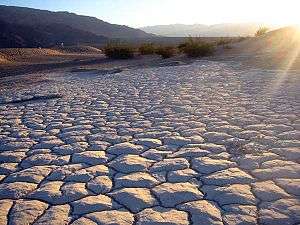
A car is highly recommended although during the more temperate seasons such as the fall and spring a nice bike ride may be in order. But beware that climatic conditions in the park can be extreme so always check the weather forecast prior to entering and plan your activities accordingly. Note that most weather forecasts for the park refer to locations within the low altitude portion of the park and weather conditions at higher elevations can be dramatically different.
The paved roads within the park are well-maintained and accessible to vehicles of all kinds, but dirt roads (with the exception of the west side around the Badwater Salt Flats) are rough. Many use a vehicle with moderately high clearance such as a four-wheel drive, but a 4-wheel drive is not essential to visit any of the main sights listed below (except Echo Canyon). Expect excessive washboarding, erosion, large rocks, and uneven surfaces when traveling on the park's dirt roads.
While well maintained paved roads traverse the park from east to west and to the south, most park features other than the visitor center will require some degree of off road travel. In most cases, this will consist of graded dirt or gravel roads. This should not be a problem for a sensibly driven SUV but all drivers should exercise caution: don't leave Furnace Creek without a full tank of gas, make sure your spare tire is serviceable, carry enough water for all passengers to last at least 24 hours (1 quart 1 L) per person minimum), don't rely on a cell phone in an emergency, carry a detailed park map and know how to read it. There is likely no other place in the lower 48 states where a traveller could so easily fall off the beaten path than in Death Valley. This advice is not meant to scare you but to remind you that overland travel in the park is serious business. The best way to travel in the park and to see the most is a with a high-clearance 4x4. This designation is used throughout the park maps to describe what vehicles should or could attempt certain routes. Only short sections of some routes might be classified as hard core but what makes the park so challenging is the length of some of the roads. Most tours into remote areas require at least an 8-hour commitment if starting from Furnace Creek, so plan accordingly. Before planning any driving off of the paved roads check with the visitor center or the park website for the latest road condition updates.
The most important thing you can do is let someone you trust know about your travel plans, and when they should expect to hear from you when you get back to civilization.
See
Death Valley and Furnace Creek
- 🌍 Artist's Palette. The rocks within this section of the park have been stained myriad colors by minerals within, creating a view that resembles an artist's palette.
- 🌍 Badwater. At 282 feet below sea level, it's the lowest point in North America. A boardwalk and signs provide info on the local environment, and a trail leads out onto the salt flats.
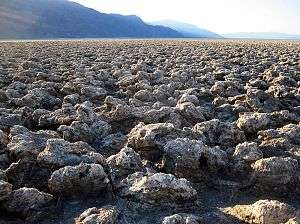
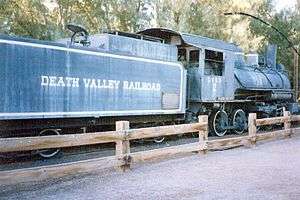
- 🌍 Dante's View. Spectacular view from an overlook just a mile or two away from Badwater, but 4000 feet taller. The road to Dante's View is a bit long, but the view is worth it. If you are towing a trailer, a parking lot is provided for you to leave your trailer behind before ascending the most difficult part of the road to Dante's View.
- 🌍 Devil's Cornfield.
- 🌍 Devil's Golf Course. A bizarre landscape consisting of a vast field of salt crystals. Please admire these carefully! A slight touch can break the crystals, which often take years to re-form.
- Echo Canyon. 4WD road just east of Furnace Creek.
- Mustard Canyon. A popular hike located just north of Furnace Creek through a brilliantly-colored canyon. The best view is from the very end of the trail, which requires traversing through some narrow canyon walls and over ladders. Star Wars fans may recognize this place as the Jawa hideouts from Episode IV.
- Mushroom Rock. This oddly shaped rock is on the road south of Furnace Creek.
- 🌍 Natural Bridge. Travel south from Furnace Creek. Natural Bridge is just east of the main road via a dirt road. This natural bridge in a narrow canyon was created when erosion managed to undercut a section of the stream bed and eventually create a bridge well above the bottom of the canyon.
- 🌍 Salt Creek. Travel north from Furnace Creek. Salt Creek is about two miles west of the main road via an easy dirt road. This place is great. Long ago Death Valley was a lake with fish in it; as the lake dried up and salinity increased the fish evolved to cope. Now they are restricted to a short, salty creek which springs up out of the desert, flows for a few hundred yards, and then disappears back into the sand.
- 🌍 Visitor Center And Museum (Furnace Creek). When visiting Death Valley, start here and you may discover that some sight you hadn't been interested in turns out to really interest you. Or just figure out which of these many places you should really visit.
- 🌍 Zabriskie Point. Famous viewpoint loved by photographers just east of Furnace Creek. View overlooks interesting weathered canyons. View is a 2-minute walk from the parking lot.
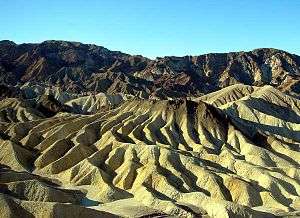
Stovepipe Wells and vicinity
- 🌍 Aguereberry Point.
- Cottonwood Canyon.
- 🌍 Darwin Falls. A 15-foot waterfall that is particularly interesting in Spring. Traveling west of Panamint Springs on SR 190, turn left onto a dirt road that goes up a wash just before SR 190 starts climbing uphill. After about half a mile of dirt, gravel and rocks, there is a small parking lot. From the parking lot, hike about half a mile to a mile further into the canyon. Since this is the drinking water supply for Panamint Springs, please do not jump in, no matter how tempting it is.
- Death Valley Buttes.
- Greenwater Ruins.
- Grotto Canyon.
- Marble Canyon. A popular hiking destination. While accessible only by a long, sandy road followed by a technical rock crawl through a wash, this hike is worth the headache (or fun) of getting to the base of the trail. Before you go, consult rangers about the location of various petrogylphs along the canyon walls. Though some have been vandalized, many are in pristine condition.
- 🌍 Mosaic Canyon. This popular hike in the center of the park winds through a narrow, marbled canyon. Some climbing and scaling of slick marbled rock is required.
- 🌍 Sand Dunes. Near Stovepipe Wells. Most people think sand dunes are common in the desert. They aren't. There are two interesting areas of sand dunes in Death Valley. The largest is Eureka Dunes, accessible only to adventurous backcountry folks. This smaller set of dunes near Stovepipe Wells is still quite impressive.
- 🌍 Stovepipe Well. This historic marker was placed at a reliable spring in order to mark its location in harsh conditions.
Scotty's Castle and vicinity
| Scotty's Castle closed: Entry to Scotty's Castle and Grapevine Canyon is prohibited. Major flooding in October 2015 caused serious damage to several buildings at the Scotty's Castle site, including the mansion, and washed out the access road through Grapevine Canyon. Repairs to the buildings are ongoing, and work on replacing the access road is expected to start in January 2018; the National Park Service expects the site to reopen sometime in 2019. |
- 🌍 Scotty's Castle (Death Valley Ranch). A strange story about the creation of elaborate mansion in the valley involving sickness, fraud, and tall tales.
- 🌍 Titus Canyon. An unimproved road into Death Valley that begins just west of Beatty (the road to Titus canyon heads north from the normal paved route from Beatty into Death Valley). Titus canyon is narrow, deep and spectacular. Due to narrowness, parts of this road are one-way, so you really need to start from the east end of the road. You don't need an off-road vehicle for this, normal cars should do fine, but don't bring the RV.
- 🌍 Ubehebe Crater. In the northern part of the park near Scotty's Castle, this giant crater was formed by volcanic activity. Walking trails lead into and around the crater, but be warned - going down into the crater is a difficult undertaking, and it may be best to enjoy the view from the top.
Backcountry sights
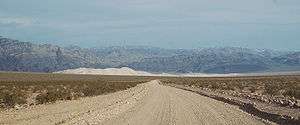
- 🌍 Barker Ranch. Charles Manson and his followers were captured here in 1969. The backcountry road up - which includes several rock falls - will make you wonder how Charles Manson got a school bus through. Many visitors who make the difficult trek stay overnight in the cabin here.
- 🌍 Charcoal Kilns. Remnants of Death Valley's mining past, these kilns are remarkably well-preserved.
- Crankshaft Junction.
- 🌍 Desolation Canyon. Because it is not marked from the road, and not well marked on the map, a hike through this canyon offers solitude even beyond that of what is a very quiet park to begin with. The canyon isn't much to look at for the first 1/2 mile of the hike from the parking area, but beyond that, there is much to explore.
- Emigrant Canyon.
- 🌍 Eureka Sand Dunes. Tucked away in the north part of the park, accessible only by tens of miles of dirt road, these are the second tallest dunes in the United States. Don't let their out-of-the-way location deter you from visiting, however. The solitude only adds to the otherworldliness of the wind-swept sands, the highly rare Eureka Grass blades grasping for life in the dry mounds, and the panoramic view of the colorful Last Chance and Saline Ranges which flank the dunes on either side.
- Ibex Dunes. Well off the beaten path in the southern end of the park, these are some of the most remote sand dunes in the American West. Mountains flank the dunes to the west and east, making both sunrise and sunset an event. The backcountry road here is rutted with arroyos, and like so many other places in the park, requires a four-wheel drive.
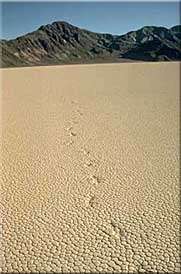
- Pleasant Canyon and South Park Canyon 4wd Loop. The South Park Canyon portion near the Panamint Valley should be attempted only by experienced drivers with high clearance vehicles.
- 🌍 Racetrack Playa. As with many points of interest within the park, this one is not easily accessible. The main route consists of 27 miles of dirt road, beginning at the Ubehebe Crater in the northern part of the park. However, the effort is well-rewarded with a site of twilight-zone proportions. The Plestiocene-era lake bed, nearly three miles long and a mile wide, is so flat that it once used as a landing strip for drug smugglers. But the Racetrack is most famous for its "moving rocks": boulders whose erratic tracks remain visible for years. Though their movement has been tracked with GPS, no adequate explanation for it has been found. In the spring months, brine shrimp - which hibernate when the water dries up, only to emerge months or even years later - are sometimes visible in the muddy puddles here.
- 🌍 Tea Kettle Junction. In the backcountry near the Racetrack Playa, this signpost is decorated with numerous tea kettles and makes for a rather odd sight in the vast desert.
- 🌍 Telescope Peak. Highest point in the park at 11,049 feet. The trailhead to the summit starts at the Mahagony Flats campground and is 12.5 miles round-trip with 3200 feet of elevation gain.
Do
There are numerous hiking trails within the park, ranging in difficulty from short loops to overnight, mountainous treks. Always bring sufficient water when hiking in Death Valley; the heat can kill.
Photography is another popular activity. The odd geologic formations in the park are great for early morning and late evening photography, although during the day the harsh sun tends to wash out most photographs. During March and April the wildflowers within the valley bloom, making it a particularly photogenic time of year.
The clear desert air, scarcity of clouds, and a great lack of nearby light pollution makes Death Valley an ideal spot for stargazing. Ideally come during a new moon to fully appreciate the darkness of the night sky.
Death Valley has numerous high-clearance roads that offer a challenge for four-wheel driving enthusiasts. Driving off-road is not permitted.
Bicycles are allowed on all roads in the park, including the many rough, trail-like backcountry roads that attract four-wheel drive enthusiasts. As with motor vehicles, riding off-road is not permitted.
Other park activities include:
- Scotty's Castle Tours. Closed due to flood damage; will not reopen until at least 2019. Before major flooding closed the site in 2015, tours of the home of an eccentric resident of Death Valley were offered daily from 9AM until 5PM, departing at least once an hour and lasting for 50 minutes. Before the closure, tickets cost $11 per person (with discounts for seniors and children), and there was often a wait for tickets. When the site reopens, expect ticket prices to be higher, and it's best to reserve tickets online at the park's site. It's expected that tickets will continue to be sold on a first-come, first-served basis.
- 🌍 Badwater ultramarathon. Only for the most experienced and committed, the 135-mile course from Badwater (elevation -282 feet) to the Mt. Whitney trailhead (elevation 8360 feet) is billed as the world's toughest race. Adding to the difficulty, the race is held annually during July, the hottest month of the year. The field is invitation-only and limited in size, but annually about 100 people toe the starting line, and 1-2 days later, after crossing two mountain ranges, 60-80% percent of those who start arrive battered, burned, and exhausted at the finish line.
Buy
- Furnace Creek Visitor's Center.
- Inn at Death Valley Gift Shop.
- Ranch General Store.
- 🌍 Borax Museum.
- 🌍 Stovepipe Wells General Store.
- Scotty's Castle Gift Shop.
Gas
Although you can get gas in the park it typically costs up to a dollar more per gallon than outside the park. It is recommended to fuel up right outside the park before coming in. But once in the park, don't try to eke out with just enough gas as the results can be fatal if you are stuck in the wilderness or just costly if you need to get gas brought to you by a tow truck.
- Furnace Creek Gas Station, 8AM-6PM (24 hours a day by credit card) on SR 190
- Stovepipe Wells Gas Station, 7AM-9PM. On SR 190 (regular gas only, usually cheapest in Death Valley proper)
- Panamint Springs, on SR 190 west.
Eat
- The Inn at Death Valley Dining Room, ☎ +1-760-786-2345. The only upscale restaurant in Death Valley, very elegant, with a somewhat laid back dress code. Closed for summer season. Reservations are required for dinner and Sunday brunch. Breakfast, lunch and dinner is served. Call for reservations.
- 49'er Cafe. In the Ranch at Death Valley, this restaurant is less upscale than the Inn at Death Valley Dining Room or the Wrangler Steakhouse, but offers decent food with dinner entrees starting around $10.
- Wrangler Buffet. In the Ranch at Death Valley, the buffet is served daily for breakfast and lunch and offers a variety of hot and cold items.
- Wrangler Steakhouse. In the Ranch at Death Valley, this upscale restaurant offers steaks and other entrees starting around $25. Open for dinner only.
- Stovepipe Wells. Restaurant and convenience store.
Drink
- Corkscrew Saloon. In the Ranch at Death Valley and providing a cowboy atmosphere, the drink prices are reasonable ($5 for a beer) and the crowd combines retired tourists with Death Valley locals, creating an interesting mix.
Sleep
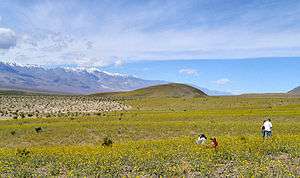
Lodging
Within the park
There are 4 in-park lodging facilities in Death Valley National Park.
- 🌍 The Inn at Death Valley, ☎ +1-760-786-2345. Formerly known as the Furnace Creek Inn, this inn advertises itself as a first class, AAA Four Diamond historic resort with 66 rooms and full amenities. Rates range from $250–$370 per room with $20 per each additional person. Closed during summer season.
- 🌍 The Ranch at Death Valley, ☎ +1-760-786-2345. Formerly known as the Furnace Creek Ranch, this establishment is the ranch style family oriented version of the above inn with 224 rooms and rates ranging from $105 to $174 depending on the season and type of room.
- 🌍 Panamint Springs Resort, ☎ +1-775-482-7680. Just inside the west entrance, this resort is the most economical lodging option. The rooms are small and very outdated. $79 to $149.
- 🌍 Stovepipe Wells Village, ☎ +1-760-786-2387. Motel-style lodging in Stovepipe Wells. The rooms are not fancy, and the running water in some rooms is not potable, but it is a perfectly comfortable and convenient place to stay. Rates tend to be cheaper than at Furnace Creek ($111 for a Deluxe room). Beware of the restaurant at Stovepipe Wells, though; it tends to be wannabe fancy and overpriced. Call early for reservations at the lodge.
Outside of the park
- Death Valley Junction is the closest town outside of Death Valley, about 30 minutes away from the visitor's center. It has one hotel, and a theatre.
- Beatty is a town outside (northeast) of Death Valley. It's a very cheap option.
- Lone Pine is two hours west of the park in California.
- Shoshone is an hour southeast of the park in California.
Camping
- 🌍 Furnace Creek. (Year round). 196 feet below sea level, Furnace Creek has 136 sites with water, tables, fireplaces, flush toilets, and dump station. No showers, but the nearby Ranch at Death Valley offers pool and shower for $5 per day. $18 per night during the winter season and $12 a night during the summer.
- 🌍 Mahogany Flat. (Closed in winter). Mahogany Flat is at 8,200 feet in the Panamint Mountains and is accessible to high clearance vehicles only. Depending upon road conditions, 4-wheel drive may be necessary. The campground has 10 sites, tables, fireplaces, and pit toilets. Free.
- 🌍 Mesquite Spring. (Year Round). At 1,800 feet 3 miles from Scotty's Castle, Mesquite Spring has 30 sites with water, tables, fireplaces, flush toilets, and a dump station. $12 a night.
- 🌍 Stovepipe Wells. (Closed in summer). At sea level, Stovepipe Wells has 190 sites with water, some tables, some fireplaces, flush toilets, and dump station. $12 per night.
- 🌍 Stovepipe Wells RV Campground. (Year round). This RV campground is managed by the Stovepipe Wells Resort. It has 14 sites with full hook-ups and no tables or fireplaces. A swimming pool and showers are available. No reservations, first come first served. $23 a night.
- 🌍 Sunset. (Closed in summer). At 190 feet below sea level, Sunset has 270 sites with water, flush toilets, and dump station. No fires allowed. $12 per night.
- 🌍 Texas Spring. (Closed in summer). At sea level, Texas Spring has 92 sites with water, tables, fireplaces, flush toilets, and dump station. Texas Spring is first come first served with self registration. From March 17 through April 15, Texas Spring is designated primarily for tent camping with a limited number of RV sites. For the summer, reservations for the two Texas Springs campground group sites are available by calling +1 760 786-3247. $14 per night.
- 🌍 Thorndike. (Closed in winter). Thorndike is at 7,400 feet in the Panamint Mountains and is accessible to high clearance vehicles only. Depending on road conditions, 4-wheel drive may be necessary. Thorndike has 6 sites, tables, fireplaces, and pit toilets. Thorndike is free. Due to extreme fire danger, campfires are prohibited at Thorndike Campground until further notice!
- 🌍 Wildrose. (Year round). At 4,100 feet in the Panamint Mountains, Wildrose has 23 sites, with tables, fireplaces, and pit toilets. Drinking water is available during the Spring, Summer, and Fall. Although it is windy enough that you'll need to take care to secure your campsite, it is still high enough in elevation that it presents more pleasant weather for camping than the valley floor. Being farther away from the more popular areas of the park induces a quieter setting as well. Free.
Backcountry
Backcountry camping is allowed 2 miles away from any developed area, paved road, or "day use only" area. Due to the rough dirt roads, backcountry roadside camping is generally only accessible to visitors with high clearance or 4-wheel drive vehicles, or well-equipped mountain bikes.
Stay safe
- See also: Arid region safety
Follow Desert Survival guidelines. The name of the park says it all. Unprepared tourists die each year within the borders of the park. Make sure you have plenty of water (at least a gallon (4 liters) per day, per person) for your activities, whether it be on a back-country trail, or on the main highway. A good rule of thumb is to always carry enough food and water for an additional 3–4 days longer than you intend to visit. Should you become stranded while driving, stay with your vehicle as it is likely to provide the only shade in the area. Pack plenty of water for your car in case of overheating, especially in summer! Rattlesnakes, scorpions, and black widow spiders are present in the park. Never place your hands or feet where you cannot see first!
If you are going a significant distance on any of the unpaved roads, phone a friend and tell them where you are going, when you will be back, when you will phone them again to tell them you are safe, and give them an emergency number to call (+1 760-786-2342) if you don't get back in touch with them by a chosen deadline. Some of the unimproved roads eat tires for breakfast, lunch, and dinner, and you could lose your spare tire too. If a road advises high clearance, 4WD vehicles, take that seriously. In addition, make sure you have more than enough fuel; roads may be impassable and can require unforeseen detours. Don't rely on a GPS routing alone. Figure out where you're going on the official national park map first, then make sure the GPS device precisely follows the same route. If in doubt as to a route's safety or your vehicle's ability to make it, return to established paved roads sooner rather than later.
While it rarely rains in Death Valley, when it does, it can rain quite heavily and the sun-baked ground has little capacity to absorb it, sometimes leading to flash floods. Don't enter any narrow canyons if rain or storms are forecast.
Cell phone service does not exist in most of the park, so don't count on being able to use it in an emergency.
Connect
Free Wi-Fi internet access is available at the Furnace Creek Visitor Center, but only when it is open.
Furnace Creek has reliable 3G service for Verizon, T-Mobile and Sprint (others may function but, there is no confirmation of this).
Some high peaks do receive signal, however, this is not to be counted on but, should be attempted in an emergency.
Go next
- Mount Whitney. The tallest mountain in the lower forty-eight states, Mt Whitney is west of the park on highway 190.
- Eastern Sierra. The Sierra Nevada mountains west of the park on highway 190 provide an ideal region for backpackers.
- Las Vegas. America's playground, Sin City can be reached via numerous routes from the south and east exits of the park.
| Routes through Death Valley National Park |
| Bakersfield ← Ridgecrest ← | W |
→ Shoshone → Pahrump |
| Ends at |
W |
→ Death Valley Junction → Ends at |